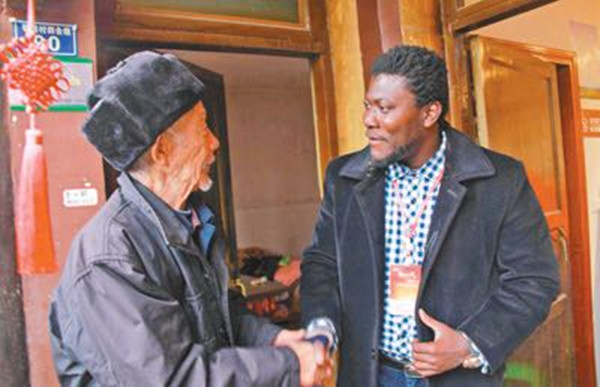Exploring Guizhou from an African viewpoint
 |
|
The author visiting Pingtang International Experience Planetarium in Guizhou Province. [Photo by gog.cn] |
I tried looking up the meaning and significance of the name Guizhou (贵州) before embarking on the trip, basically to have a reasonable idea of what was in store for me but that was a hard task so I inquired from a Chinese colleague among a group of local and foreign journalists on the trip. From what she said, the province was named after a famous mountain called "Gui" (贵), sort of noble in literal translation and “zhou”(州)which simply means province in Chinese.
With that in mind I set out on a journey of discovery and what I found was mind blowing, a photographer's paradise. Generally described as a mountainous province in southwestern China, with Guiyang as its capital, the province is truly one of nature’s best kept secrets. I recommend road transport - awesome breathtaking views dotted along the highway throughout the province will leave first time visitors spellbound.
Compared to other leading provinces in China, with regards to development, Guizhou has some catching-up to do, however the province remains unique not only for its amazing landscape, but for the role it played in the political history of modern China and the role it is to play in the world, in mankind's search for life beyond our planet, later to be explored in another article.
 |
|
The author in Guizhou Province. [Photo provided to chinadaily.com.cn] |
Our trip began in Zunyi city, north of Guizhou province, where the group played host at a ceremony to commemorate the famous 'Zunyi Conference'. Not much is known about this famous conference in Africa and the western world, but apparently it was at this conference that China's first leader and Chairman of the Communist Party of China, Mao Zedong, was elected by the Politburo to lead the Communist forces (Red Army) on the historical Long March in the fight against Nationalist forces led by Chiang Kai-Shek from 1934-35.
The location of the conference has been well preserved, the original two-storey wooden-building, the conference hall where the meeting took place, the furniture and various items used by officials who were present at the meeting are all intact to this day.
We continued our journey the next day to two adjoining villages, Gouba and Huamao. The two villages played key roles in Chairman Mao's grand strategy in the fight against Nationalist forces. It is for this reason that I believe Guizhou's role in the victory against the Nationalist forces and China's eventual liberation cannot be easily overlooked and neither can it be dismissed. I am confident that the China we are witnessing today wouldn't have achieved the height and success it is experiencing- confident, ambitious, and a leading power in the world if Gouba and Huamao hadn't welcomed the Red Army. Chairman Mao chose to position his forces at the base of a mountain in Gouba to prevent Nationalist forces from attacking their camp from behind and subsequent bombardment, that way; the Red Army could meet enemy forces in a frontal attack. According to historical accounts, it was a matter of life-and-death. That was the breaking point. Defeat could have meant the non-existence of the People's Republic of China we know today. As we toured the living quarters of the soldiers I tried to visualize the tension during the encampment. Facing the enemy boot-for-boot, I believe, was the sort of guerrilla tactics Chairman Mao was noted for. Standing at that historical site where the Red Army stationed gave me a better understanding of the resilience of the Chinese nation.
To that end, it is important to preserve and protect these sites as a form of political, historical and cultural education of the younger generation. Buildings and structures in the two villages have been upgraded with support from local government to compliment the improved standard of living of resident peasant farmers whiles the original station of the Red Army have been renovated, restored and now called the "Red Army village". Local wine making, horticulture, pottery, and umbrella making using the original paper making technique are contributing immensely to wealth creation in the area.
Our last stop was in Guiyang, the provincial capital where massive infrastructural development has already taken shape and will soon catch-up with top tier cities. This is where the world's largest telescope, the Five-hundred-meter Aperture Spherical Radio Telescope (FAST) is located. Situated in a deep valley in Pintang county, southwest of Guizhou, I call it the "Earth's Ear". We were granted an exclusive tour of the facility. As a general rule and strictly observed, no cameras, mobile phones or any electromagnetic device are allowed within a five-kilometre range of the facility- the reason being that such devices could disrupt the debugging process of the telescope.
The telescope is on a mission to seek the origin and evolution of our universe. Since the beginning of time, man has been fascinated about life beyond our planet. Historical accounts of the Egyptians, Mayans, and ancient Chinese philosophers using devices to explain astral phenomenon and the existence of extraterrestrial beings "aliens" abound in numbers. In our current technological world, Guizhou is leading the charge in man's search for life beyond our universe with FAST, said to be 10 times as sensitive as the Arecibo telescope in Puerto Rico.
The province is also home to one of China's national big data centres, whose core objectives are data storage, data collection, data processing and analysis, cloud platform construction and operation services, data security, data exchange and transaction, and artificial intelligence. Big data has been described as the diamond mine of the 21st century, I prefer to call it the "new virtual economy", and Guizhou is one of the cities at the forefront of the "big data revolution". For a general understanding, the big data industry supports smart health, smart logistics, internet finance, e-commerce, smart tourism, smart agriculture, energy, education, and public security.
Statistically, the province has been one of the top performing regions in China in recent years. Guiyang clinched the number one position among the top 20 cities in the Rising Stars: China emerging city rankings compiled by The Economist Intelligence Unit in 2015. In the 2016 top 10 Chinese cities with best performance released by The Milken Institute, Guiyang again placed first, with Shanghai and Tianjin in second and third position respectively.
I have seen it myself, Guizhou's rise is visible. The region welcomes both local and foreign enterprises, as well as talents, with the establishment of an international talent park to support industries. I'm positive that the contribution of Guizhou to the sustenance of the national economy is the reason why China’s economy has sustained the momentum regardless of predictions of decline.
The author is a former Ghanaian Journalist.
- Guizhou's first 5-level interchange opens to traffic
- Guizhou invests $400 million in building factory in Vietnam
- An American girl becomes a town mayor in Guizhou
- Stock right transfer dispute between Mou Yingming, Guizhou-based Wandong Real Estate Development Co, Ltd, Zhao Weiqun, Zhang Feng, Zhou Xingyu and Sizhou-based Yichang Trading Co, Ltd
- Guizhou architects win thumbs up from Germany
















